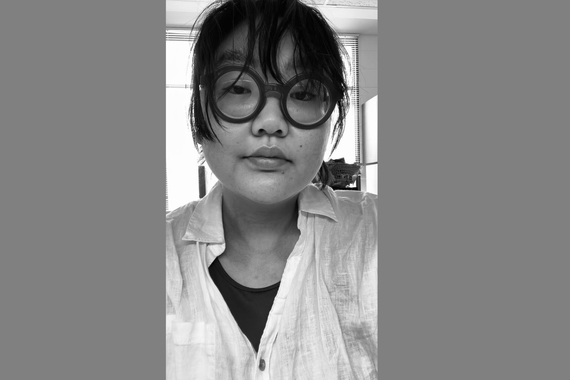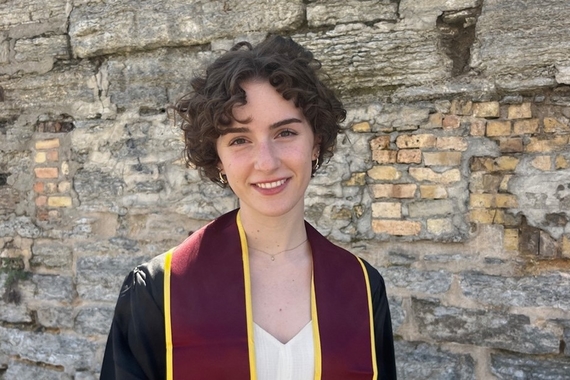Bringing Ephemeral Art to Life
Forty-odd students and a few professors traverse the city of Portland, Oregon in 1973, each carrying a full-length mirror. Pausing in the grass or on a busy street, they adjust their mirrors to frame one another’s reflections as they move farther and farther apart. A bizarre scene from the perspective of a passerby, this interactive activity is actually a carefully composed work of art by Allan Kaprow (1927-2006) entitled Routine.
What was the purpose of such a performance, what makes it art, and why would students want to participate? These are some of the questions that Visiting Assistant Professor Emily Capper explores in a book she is writing about Kaprow’s work, currently titled Happening Pedagogy: Allan Kaprow’s Experiments in Instruction. In part, she says, artworks like Routine reflect Kaprow’s philosophy of teaching, which he honed over decades as a professor. By asking students to frame, describe, and analyze each other’s movements in a mirror, Kaprow taught them classic methods of close looking and visual description from the discipline of art history while actively involving their bodies, personalities, and social habits.
Studying performances that occurred so far in the past is no straightforward task. Compared to a painting or sculpture, a live performance is ephemeral. Artists like Kaprow, however, consciously preserve their works using a variety of techniques—from audio recording to photography to printed musical scores. The musical score, in particular, was of great interest to Kaprow, who studied closely with the experimental composer John Cage (1912-1992). Cage famously bypassed traditional musical forms in favor of the unpredictable world of everyday sounds and actions; he recognized that, in Capper’s words: “there is no such thing as silence; there’s always sound.”
There's an App for That
Beyond her book project, Capper joined a team working on a digital humanities project organized by the Getty Research Institute in Los Angeles. Their goal is to present experimental performance scores from Cage and other artists, including Kaprow’s Routine, in the form of a web application. The application’s purpose is to highlight artists from the 1950s and ‘60s who were inspired by Cage’s work. The team is working with 11 experimental scores that were either written by Cage or by artists in dialogue with him.
By digitizing these works, Capper and her team allow people to interact with the complex, ephemeral artworks at leisure. Users can explore animations, audio recordings, photographs, and videos of numerous performances that bring the scores to life. Capper explains that “in some ways, these experimental works are not meant to be seen in a gallery setting” because studying the physical sheet of a score under glass removes some of the excitement. Given the state of digital technology today, Capper believes this will “be a good medium for helping students and others appreciate how productive these experimental scores were, and how differently they were performed in various contexts. Who knows? Students may even be inspired to devise their own realizations!”
Organizing the performance documentation is complicated because of its abundance, but Capper and her team are working hard to make the application available for the public. Once the app is released, it will open up a whole new world for understanding and interpreting experimental scores.
Intersecting Disciplines
Capper has always been interested in exploring the intersection of various art forms. As an undergraduate, she created her own major in “modernist studies,” which encompassed art history, film studies, literature, and the history of dance, and is currently teaching in two different departments at UMN: art history and cultural studies & comparative literature (CSCL).
Not long after graduating from the University of Chicago with a joint PhD in art history and cinema and media studies, Capper began teaching at UMN. She enjoys intertwining the material from her two different disciplines to give the courses more dimension. “It’s very exciting and satisfying to me to move between the two because they attract different kinds of students with different perspectives,” Capper explains.
Students in all of her classes receive exposure to different art forms. For example, Capper’s art history students can learn more about popular media and the theoretical concerns seen within CSCL, while CSCL students can observe and develop a deeper understanding of art history. Additionally, Capper serves as a faculty advisor for the CSCL Student Association, which allows her to develop connections with her students beyond an academic context. This gives her a better sense of what students’ interests are and how she can foster a closer relationship with them inside and outside of the classroom. “A really successful classroom is one where you actually are communicating and changing things in light of students’ interests,” Capper says.
Mind the Gap
Capper’s main focus as a teacher is bridging the gap between art institutions and students unfamiliar with them. “I really like to try and use classes as much as possible to get students really comfortable with going to see contemporary art—as intentionally strange and, sometimes, opaque as it is—so they’re able to walk into the Walker Art Center and own the place and know that they belong there,” Capper explains. She hopes she can prepare students to engage with the art community in a new way by the end of her class.
With its numerous and longstanding institutions dedicated to fostering experimental art beyond the bounds of a commercial art gallery, the Twin Cities is a great place to do that. “The students here are inspiring to teach,” Capper says. “Nothing is more rewarding than to see them forge their own unique paths through the world of art with confidence.”
This story was written by an undergraduate student in CLA.



